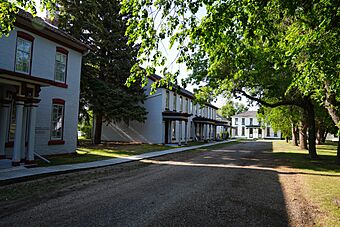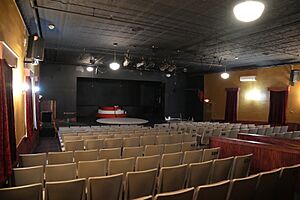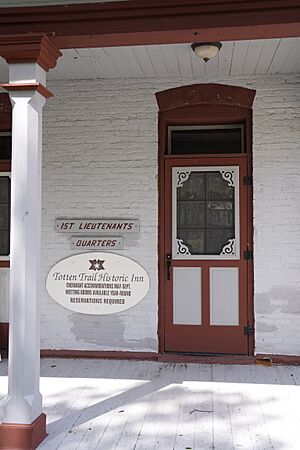Fort Totten State Historic Site facts for kids
Quick facts for kids |
|
|
Fort Totten
|
|

Buildings at Fort Totten in 2021
|
|
| Location | South of Fort Totten off ND 57 |
|---|---|
| Nearest city | Fort Totten, North Dakota |
| Area | 9.81 acres (3.97 ha) |
| Built | 1868 |
| NRHP reference No. | 71000629 |
| Added to NRHP | December 9, 1971 |
Fort Totten State Historic Site is an old fort located by Devils Lake in Fort Totten, North Dakota. For 13 years, this fort helped keep peace among local Native American tribes. It also protected important travel routes during the American Indian Wars.
After it closed as a fort in 1890, it became a school for Native American children. This school was called the Fort Totten Indian Industrial School and operated until 1959. In 1971, Fort Totten was added to the National Register of Historic Places. Experts from the State Historical Society of North Dakota called it one of the best-preserved military posts from that time.
Contents
Fort Totten's Story
Building a Frontier Fort
Fort Totten was one of many forts built in the western United States during the American Indian Wars. After the Dakota War of 1862, many Dakota people moved to the area around Devils Lake. These people now form the Spirit Lake Tribe.
In the 1860s, military leaders planned to build forts across the new Dakota Territory. One fort was planned for Devils Lake. Even though these plans were paused, the idea came back in 1867. This was because of a new treaty that created two reservations, including the Devils Lake Indian Reservation. This reservation is now known as the Spirit Lake Indian Reservation.
Fort Totten officially opened on July 17, 1867. It was named after Joseph Gilbert Totten, a leader in the United States Army Corps of Engineers.
Life at the Fort
The Spirit Lake Tribe faced many challenges, especially during the harsh winter of 1866–1867. So, the fort's first jobs were to help the tribe and protect them from attacks. The first fort was a temporary one, built quickly from oak logs. It had an 18-foot-tall (5.5 m) log fence around it.
By 1868, soldiers began building stronger, more permanent buildings. The main new building was finished in 1871. Over the next ten years, many more buildings were added. They formed a square around a central area used for drills and parades. New buildings included a hospital, dining hall, barracks (where soldiers lived), and storage areas.
Most of these buildings were made from bricks. The bricks came from local clay, and lime was found at Devils Lake. Later, stables for horses, a brewery, and a store were also built. Many of these original buildings are still standing today.
In 1873, soldiers from the 7th Cavalry Regiment joined the fort. They stayed until the fort closed. Soldiers from Fort Totten also helped set up the St. Michael's Mission school nearby in 1874. The fort was also a starting point for a team surveying the border between the United States and Canada.
Why the Fort Closed
As conflicts became less common, the army found it harder to justify keeping so many forts open. Fort Totten was in a very rural area and rarely saw any fighting. Also, the Spirit Lake Tribe had become self-sufficient.
Historians note that the army's presence at Fort Totten became less helpful over time. The Spirit Lake Tribe had their own government and police, who sometimes disagreed with the soldiers. With less to do, some soldiers at the fort became unruly. Because the army could no longer justify its presence, Fort Totten closed on December 20, 1890.
From Fort to School
The Boarding School Era
After the fort closed, the Bureau of Indian Affairs took it over. They turned it into a Native American boarding school called the Fort Totten Indian Industrial School. The school aimed to teach local Native American children new ways of life.
Students had regular school classes. They also learned practical skills. Girls learned cooking and cleaning. Boys learned carpentry, woodworking, farming, and other trades. Most students came from western North Dakota and Montana. Many local families preferred St. Michael's Mission because Fort Totten had strict rules and only taught in English.
The school had strict punishments for students who broke rules. By 1910, some local students could live at home and travel to school each day. This helped increase student numbers. The school briefly closed from 1917 to 1919 due to money problems. At its busiest, the school had up to 400 students.
Changes to the Buildings
The fort's buildings needed a lot of care by the time the school opened. The cold, humid weather meant the brick buildings needed frequent painting. Students often helped with this work.
Some original fort buildings were torn down during the school years. These included a guardhouse and part of a dining hall. A gymnasium was built where some old buildings once stood. Hallways were added to connect some of the old barracks to officers' quarters. A water tower was also built. The Fort Totten Little Theater, built during this time, is still used today.
Later Years and Historic Site
By the time the Great Depression started, the school had become partly a day school. It still had dorms for students who boarded there. From 1935 to 1939, it also helped Dakota children with tuberculosis.
The school's money problems continued after the Great Depression. In 1959, a new school campus opened nearby. On March 6, 1959, Fort Totten school closed. The property was then given to the State Historical Society of North Dakota in 1960.
Fort Totten became a North Dakota State Historic Site that same year. It was listed on the National Register of Historic Places on December 9, 1971. The state provided money to fix up the buildings. Today, only the buildings and the area around the central square are part of the historic listing.
One of the old officers' quarters was restored in 2001 and 2002. It is now the Totten Trail Historic Inn. This inn works as a hotel and a place for events. In 2015, the state and the State Historical Society raised money for more renovations.
Visiting Fort Totten Today
Visitors to Fort Totten can explore an interpretive center. They can take a walking tour of 16 original buildings. There is also the Pioneer Daughter's Museum to visit. You can even watch a show at the Fort Totten Little Theatre. For a unique experience, you can stay at the Totten Trail Historic Inn. Each September, school children often attend the "Fort Totten Living History Field Day."
Images for kids









